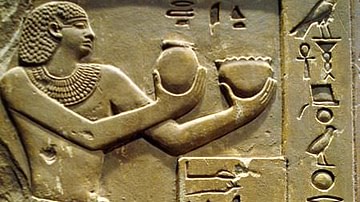
The Rosetta Stone is an incomplete grey and pink granodiorite stela dating from 196 BCE which presents a priestly decree concerning King Ptolemy V of Egypt. The text is in three different versions: Hieroglyphic, Demotic and Greek, a fact which immeasurably helped to finally decipher Egyptian hieroglyphics. The Rosetta Stone is today on display in the British Museum, London.
Recovery
The Rosetta Stone was discovered at Port Saint Julien, el-Rashid (Rosetta) on the Nile Delta in Egypt in 1799 CE by Pierre François Xavier Bouchard. Bouchard was an officer of engineers in Napoleon's army, and he extracted the stone from an old wall which was being demolished as part of the construction work on Fort Julien. Bouchard's commanding officer, one General Menou, realising its importance, had the stone sent to Alexandria. Casts and copies were made, but the stone was later seized by the British general Tomkins Turner and so the artefact eventually found a permanent home in the British Museum in London.
Several noted international scholars endeavoured to use the Rosetta stone to decipher hieroglyphics, but it was the Englishman Thomas Young who first identified some of the hieroglyphs which related to Ptolemy V Epiphanes (205-180 BCE) and the direction in which the symbols should be read. However, it was in the early 1820s CE that the Egyptian language text was fully deciphered by the French scholar Jean-François Champollion who discovered that the hieroglyphics were, in fact, a mixture of alphabetic, determinative and syllabic elements. Consequently, the full significance of Egyptian hieroglyphs, lost for 1600 years, was finally re-discovered.
Properties
The Rosetta Stone is a stone slab measuring 112.3 by 75.7 cm, and it is 28.4 cm thick. The text on the Rosetta stone is composed of an Egyptian hieroglyphic text of 14 lines, a demotic text of 32 lines and a Greek inscription of 54 lines. As portions of the stela are missing - especially the two top corners and bottom right corner - none of the texts are complete. Hieroglyphs was the language of Egyptian priests, demotic script was the commonly used language and Greek was used for administrative purposes. The text of all three writing systems refers to a decree passed by a priestly council of Memphis which affirms the royal cult of King Ptolemy V Epiphanes of Egypt, one year after his coronation.

The Rosetta Stone Text
The text of the Rosetta Stone begins with a lengthy praise of the achievements and good rule of Ptolemy V. We are told the king has brought great prosperity to Egypt and he has invested large sums of money on temples, both building new ones and restoring old ones, and he has provided grain for the people. Taxes have been reduced or eliminated, and many prisoners who were previously considered enemies of the state have been released during his reign. The king has also quashed Egypt's enemies, and a specific campaign against an enemy fortress is mentioned, the fall of which was due to canals being dammed to block the city's water supply. To honour all of these deeds, a statue of the king wearing ten gold diadems is to be set up in all temples titled 'Ptolemy Defender of Egypt' and attended to by priests three times a day. He is recognised as the god Ptolemy Epiphanes Eucharistos and as beloved of Ptah. The king's birthday and coronation date are to be celebrated as festivals with libations, sacrifices and feasting, and, likewise, each last day and 17th day of each month are to be days of celebration in honour of the great ruler, beloved by the gods, Ptolemy V. The text concludes by stating that these decrees should be written in stone in three texts - sacred, document and Greek writing - and the stones set up in all temples by the side of the statue of this great king who will live for all time.





